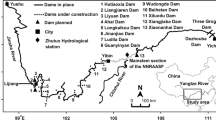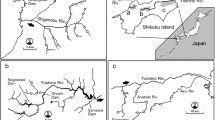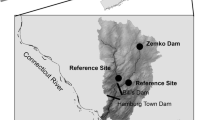Abstract
The erection of dams alters habitat and longitudinal stream connectivity for migratory diadromous and potamodromous fish species and interrupts much of organismal exchange between freshwater and marine ecosystems. In the US, this disruption began with colonial settlement in the seventeenth century but little quantitative assessment of historical impact on accessible habitat and population size has been conducted. We used published surveys, GIS layers and historical documents to create a database of 1356 dams, which was then analyzed to determine the historical timeline of construction, use and resultant fragmentation of watersheds in Maine, US. Historical information on the anadromous river herring was used to determine natural upstream boundaries to migration and establish total potential alewife spawning habitat in nine watersheds with historic populations. Dams in Maine were constructed beginning in 1634 and by 1850 had reduced accessible lake area to less than 5% of the virgin 892 km2 habitat and 20% of virgin stream habitat. There is a near total loss of accessible habitat by 1860 that followed a west-east pattern of European migration and settlement. Understanding historic trends allows current restoration targets to be assessed and prioritized within an ecosystem-based perspective and may inform expectations for future management of oceanic and freshwater living resources.



Similar content being viewed by others
References
Ames EP (2004) Atlantic Cod stock structure in the Gulf of Maine. Fisheries 29:10–28
Anonymous (1798) Legislature of Massachusetts. The Eastern Herald and Gazette of Maine [Portland] 26 March, 1798
ASMFC (2009) Amendment 2 to the Interstate Fishery Plan for shad and river herring (river herring management). Atlantic States Marine Fisheries Commission
Atkins CG (1887) The river fisheries of Maine. In: Goode BG (ed) The fisheries and fishery industries of the United States, Section V, vol. 1, pp 673–728
Atkins CG, Foster N (1868) First Report of the Commissioners of Fisheries of the State of Maine, 1867. Owen and Nash, Printers to the State, Augusta, ME
Atkins CG, Foster N (1869) Second Report of the Commissioners of Fisheries of the State of Maine, 1868. Owen and Nash, Printers to the State, Augusta, ME
Atkins CG, Stillwell EM (1874) Obstructions to the upward movement of fishes in streams, and the remedy In: US Commission of Fish and Fisheries, Part II, Report of the Commissioner for 1872 and 1873. Appendix E; Sections XXIII and XXIV. Government Printing Office, Washington, DC, pp 589–621
Baird ST (1872) Letter to Maine Commissioner of Fisheries on the diminution of the supply of food-fishes. In: Atkins CG (ed) 1872 Sixth Report of the Commissioners of Fisheries of the State of Maine, 1872. Owen and Nash, Augusta, ME, pp 7–10
Baird ST (1883) US Commission of Fish and Fisheries Report of the Commissioner for 1883. Government Printing Office, Washington, DC
Bigelow HB, Schroeder WC (1953) Fishes of the Gulf of Maine. US Fish and Wildlife Service Fishery Bulletin #74, vol 53. US Government Printing Office, Washington, DC, 577 pp
Bilby RE, Fransen BR, Bisson PA (1996) Incorporation of nitrogen and carbon from spawning coho salmon into the trophic system of small streams: evidence from stable isotopes. Can J Fish Aquat Sci 53:164–173
Brady PD (2009) Marine fisheries to work with local river herring officials on sustainable management of Massachusetts River Herring. DMF News 30: 9. Massachusetts Department of Marine Fisheries, Boston, MA
Brown ME, Maclaine JE, Flagg L (2008) Anadromous fish restoration in the Androscoggin River Watershed. 2007 report on the operation of the Brunswick fishway. FERC #2284, Maine Dept of Marine Resources. PL 89-304, 28 pp
Clark CE (1970) The Eastern Frontier: the settlement of Northern New England 1610–1713. Alfred A Knopf, New York, 419 pp
Cote D, Kehler DG, Bourne C, Wiersma YF (2009) A new measure of longitudinal connectivity for stream networks. Landscape Ecol 24:101–113
Dynesius M, Nilsson C (1994) Fragmentation and flow regulation of river systems in the Northern third of the World. Science 266(5186):753–762
Ellison AM, Bank MS, Clinton BD, Colburn EA, Elliott K, Ford CR, Foster DR, Kloeppel BD, Knoepp JD, Lovett GM, Mohan J, Orwig DA, Rodenhouse NL, Sobczak WV, Stinson KA, Stone JK, Swan CM, Thompson J, Von Holle B, Webster JR (2005) Loss of foundation species: consequences for the structure and dynamics of forested ecosystems. Front Ecol Environ 3(9):479–486
Emery E (1901) In: Emery WM (ed) The history of Sanford Maine 1661–1900. Fall River, ME, 537 pp
Fay C (2003) Biological and ecological role of alewives. Maine Rivers annual conference 2003, September 27–28, 2003 Indian Island, ME
Federal Register (2006) Vol 71, No 200/Tuesday, October 17, 2006/Notices, pp 61022–61025
Foster DR (2002) Thoreau’s country: a historical-ecological perspective to conservation in the New England landscape. J Biogeogr 29:1537–1555
Foster DR, Motzkin G, Slater B (1998) Land-use history as long-term broad-scale disturbance: regional forest dynamics in central New England. Ecosystems 1:96–119
Foster DR, Motzkin G, Bernardos D, Cardoza J (2002) Wildlife dynamics in the changing New England landscape. J Biogeogr 29:1337–1357
Foster DR, Swanson FJ, Aber JD, Burke I, Brokaw N, Tilman D, Knapp A (2003) The importance of land-use legacies to ecology and conservation. Bioscience 53:77–88
Graham J, Engle S, Recchia M (2002) Local knowledge and local stocks: an atlas of groundfish spawning in the Bay of Fundy. The Centre for Community-based Management, Extension Dept., St. Francis Xavier University, Antigonish, NS, Canada
Greenleaf M (1829) A survey of the State of Maine: In: Reference to its geographical features, statistics and political economy. Shirley and Hyde, 460 pp
Haila Y (2002) A conceptual genealogy of fragmentation research: from island biogeography to landscape ecology. Ecol Appl 12(2):321–334
Hilborn R, Quinn TP, Schindler DE, Rogers DE (2003) Biocomplexity and fisheries sustainability. Proc Natl Acad Sci 100:6564–6568
Humphries P, Winemiller KO (2009) Historical impacts on river fauna, shifting baselines, and challenges for restoration. Bioscience 59(8):673–684
IUCN (2003) Guidelines for application of IUCN Red List criteria at regional levels: version 3.0. IUCN Species Survival Commission. IUCN, Gland, Switzerland and Cambridge, UK, ii + 26 pp
IUCN Standards and Petitions Working Group (2008) Guidelines for using the IUCN Red List categories and criteria. Version 7.0. Prepared by the Standards and Petitions Working Group of the IUCN SSC Biodiversity Assessments Sub-Committee in August 2008. Downloadable from http://intranet.iucn.org/webfiles/doc/SSC/RedList/RedListGuidelines.pdf
Jackson JBC (2008) Ecological extinction and evolution in the brave new ocean. Proc Natl Acad Sci 105(Suppl 1):11458–11465
Jackson JBC, Kirby M, Berger W, Bjorndal KA, Botsford L, Bourque BJ, Bradbury RH, Cooke RG, Erlandson J, Estes JA, Hughes TP, Kidwell S, Lange C, Lenihan H, Pandolfi JM, Peterson C, Steneck R, Tegner MJ, Warner RR (2001) Historical overfishing and the collapse of coastal ecosystems. Science 293:629–638
Judd RW (1997) Common lands, common people. Harvard University Press, Cambridge, MA, 335 pp
Kline TC, Goering JJ, Mathisen OA, Poe PH, Parker PL (1990) Recycling of elements transported upstream by runs of Pacific salmon I ∂15N and ∂13C evidence in Sashin Creek, southeastern Alaska. Can J Fish Aquat Sci 47:136–144
Kritzer J, Black P (2007) Oceanic distribution and bycatch of river herring. An analysis of federal fishery-independent and fishery-dependent data. Progress report. October 2007. Environmental Defense
Lichter J, Caron H, Pasakarnis TS, Ridgers SL, Squiers TS Jr, Todd CS (2006) The ecological collapse and partial recovery of a freshwater tidal ecosystem. Northeastern Nat 13(2):153–178
Lotze HK, Milewski I (2004) Two centuries of multiple human impacts and successive changes in a North Atlantic food web. Ecol Appl 14(5):1428–1447
Lotze HK, Lenihan HS, Bourque BJ, Bradbury RH, Cooke RG, Kay MC, Kidwell SM, Kirby MX, Peterson CH, Jackson JBC (2006) Depletion, degradation, and recovery potential of estuaries and coastal seas. Science 312(5781):1806–1809
MacAvoy SE, Macko SA, McIninch SP, Garman GC (2000) Marine nutrient contributions to freshwater apex predators. Oecologia 122:568–573
Maine Secretary of State. Fish Inspector Records (1804–1893) Boxes 1–9. Maine State Archives. Augusta, ME
MBSRFH (2007) Draft strategic plan for the restoration of diadromous and resident fishes to the Penobscot River. Maine Bureau of Sea-Run Fisheries and Habitat, Department of Marine Resources, Augusta, ME
MDEP (2009) January 1, 2009 status reports: hydropower projects in Maine, DEPLW0363-H2009, and Dam Removals in Maine and Dams Subject to Regulated Minimum Flow Releases. Maine Department of Environmental Protection
MDMR (1982) Statewide river fisheries management plan. Maine Department of Marine Resources, Maine Department of Inland Fisheries and Wildlife, and Atlantic Sea Run Salmon Commission. State of Maine Augusta, ME
MDMR (2008) Kennebec River anadromous fish restoration Annual progress report—2007. Maine Department of Marine Resources, Bureau of Sea-Run Fisheries and Habitat, 131 pp
MEGIS (2004) Watershed, county line and coast base layers. Maine Geographic Information Systems (comp, ed), United States Geological Survey. Last accessed April 2009 at http://megismainegov/catalog/
MEGIS (Maine Geographic Information Systems) (comp, ed), Army Corp of Engineers (USACE), Maine Emergency Management Agency (MEMA), Maine Department of Environmental Protection (MEDEP)(comp, ed) (2006) Impound database. Last accessed August 2008 at http://megismainegov/catalog/catalogasp?state=2andextent=cover
Moody RE (1933) The Maine Frontier 1607–1763. Yale University, New Haven, CT, 462 pp
Morita K, Morita SH, Yamamoto S (2009) Effects of habitat fragmentation by damming on salmonid fishes: lessons from white-spotted charr in Japan. Ecol Res 24(4):711–722
Mullen DM, Fay CW, Moring JR (1986) Species profiles: life histories and environmental requirements of coastal fishes and invertebrates (North Atlantic)—alewife/blueback herring U S Fish Wildl Serv Biol Rep 82(1156) U S Army Corps of Engineers, TR EL-82-4, 21 pp
Pardue GB (1983) Habitat suitability index models: alewife and blueback herring. USFWS, FWS/OBS-82/10.58, 22 pp
Pess GR, McHenry ML, Beechie TJ, Davies J (2008) Biological impacts of the Elwha River dams and potential salmonid reasons to dam removal. Northwest Sci 82(Sp Iss SI):72–90
Petts GE (1989) Perspectives for ecological management of regulated rivers. In: Alternatives in regulated river management by JA Gore and GE Petts. CRC Press, pp 3–24
Poff NL, Hart DD (2002) How dams vary and why it matters for the emerging science of dam removal. Bioscience 52(8):659–668
Poff NL, Allan JD, Bain MB, Karr JR, Prestegaard KL, Richter BD, Sparks RE, Stromberg JC (1997) The natural flow regime: a paradigm for river conservation and restoration. Bioscience 47(11):769–784
Poole G (2002) Fluvial landscape ecology: addressing uniqueness within the river discontinuum. Freshw Biol 47:641–660
Pope CH (1965) The pioneers of Maine and New Hampshire 1623 to 1660. Originally published Boston, 1908. Geneological Pub Co, Baltimore, MD, 252 pp
Pringle CM, Freeman MC, Freeman BJ (2000) Regional effects of hydrologic alterations on riverine macrobiota in the New World: tropical-temperate comparisons. Bioscience 50:807–823
Rounsefell GA, Stringer LD (1945) Restoration and management of the New England alewife fisheries with special reference to Maine. US Department of the Interior, Fish and Wildlife Service. Trans Am Fish Soc 73:394–424
Saunders R, Hachey MA, Fay CW (2006) Maine’s diadromous fish community: past, present, and implications for Atlantic salmon recovery. Fisheries 31(11):537–547
Schindler DE, Scheuerell MD, Moore JW, Gende SM, Francis TB, Palen WJ (2003) Pacific salmon and the ecology of coastal ecosystems. Front Ecol Environ 1(1):31–37
Smith HM (1899) Notes on the extent and condition of the alewife fisheries of the United States in 1896. In: US Commissioner of Fish and Fisheries Report part XXIV for the year ending June 30, 1898. Government Printing Office, Washington, DC, pp 31–43
Walter RC, Merritts DJ (2008) Natural streams and the legacy of water-powered mills. Science 319:299–304
Walters AW, Barnes RT, Post DM (2009) Anadromous alewives (Alosa pseudoharengus) contribute marine-derived nutrients to coastal stream food webs. Can J Fish Aquat Sci 66:439–448
Wells W (1869) The Waterpower of Maine Hydrographic Survey of Maine Sprague. Owen and Nash, Printers to the State, Augusta, ME, 526 pp
Willis TV (2006) St. Croix River alewife—smallmouth bass interaction study. Final Report to Maine Rivers, Hallowell, Maine
Wu J, Huang J, Han X, Zongqiang X, Gao X (2003) Three Gorges Dam—experiment in habitat fragmentation? Science 300:1239–1240
Wu J, Huang J, Han X, Gao X, He F, Jiang M, Jiang Z, Primack RB, Shen Z (2004) The Three Gorges Dam: an ecological perspective. Front Ecol Environ 2(5):241–248
Acknowledgments
This work has benefited from conversations with Robert M. Cerrato, William Leavenworth, Karen Alexander, Theodore Willis, Michele Dionne, Gail Wippelhauser and Tom Squiers. We are indebted to the staff of The Maine Historical Society, The Maine State Archives, The Fogler Library Special Collections at the University of Maine Orono, and The Bangor Public Library Local History/Special Collections. We would like to thank J Wu, G Poole, D Cote and 1 anonymous reviewer for comments that improved this manuscript. We also thank undergraduate researchers Jaime Wright and Veronica Scorcia. This research was funded by a 2007 Mia J. Tegner Memorial Research Grant in Marine Historical Ecology and Environmental History (awarded to Adrian Jordaan) and NOAA award NA07NMF4550320.
Author information
Authors and Affiliations
Corresponding author
Electronic supplementary material
Below is the link to the electronic supplementary material.
Rights and permissions
About this article
Cite this article
Hall, C.J., Jordaan, A. & Frisk, M.G. The historic influence of dams on diadromous fish habitat with a focus on river herring and hydrologic longitudinal connectivity. Landscape Ecol 26, 95–107 (2011). https://doi.org/10.1007/s10980-010-9539-1
Received:
Accepted:
Published:
Issue Date:
DOI: https://doi.org/10.1007/s10980-010-9539-1




